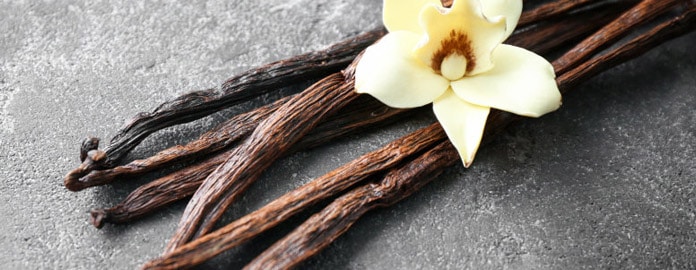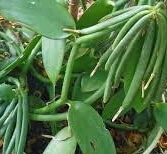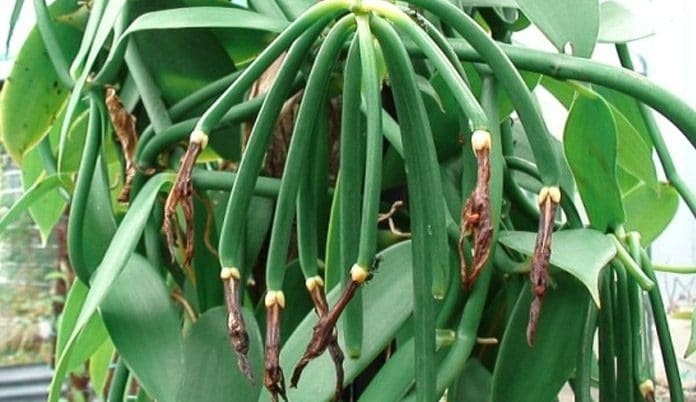Presently, there is so much interest in vanilla globally due to shortages and a rise in price. The availability of vanilla in the market is subject to the quantity produced per year. That is why Nigeria should take advantage of this and start commercial vanilla farming like Uganda.
In case you are asking if vanilla can do well in Nigeria and in Africa as whole, the answer is yes. It does well in tropical lowland regions but with vine you can cultivate it anywhere. Uganda have seen the potentials in vanilla farming and are already exporting vanilla extract and pods.
Real natural Vanilla is very expensive but highly sought for. It is said to be the second most expensive spice in the world after saffron. Some middle men in Uganda hoard the products for it to become scarce so that the price can go up the more. Vanilla is very costly because the process of production is difficult.
Madagascar vanilla sector produces 80% of the vanilla beans sold in the global market. For now no country can challenge them to that.
Description
Vanilla bean plant is a flowering vine from the orchid family Orchidacea. The commonest vanilla bean plant is the flat-leave vanilla plant (V. Planifolia) it originates from Mexico where most flavored vanilla comes from. Vanilla is easily ecposed to diseases because it requires warm tropical climate.
Vanilla plants are climbers, they grow well on high humidity and bright sunlight that is not directly hitting the plant. The ideal temperature for vanilla farming is extremely warm temperature. It will not bloom if it grows under low light conditions and if otherwise vanilla pods will not develop. Vanilla farming is possible in Nigeria and in any other part of West Africa if the right growing conditions are applied.
However, these conditions must be met for vanilla to grow well;
- Constant warm temperature
- Indirect bright sunlight
- High humidity.
The best way to grow vanilla is through greenhouse, it will help in providing them with the required growing conditions. But you can create similar environment to your home growing vanilla by keeping the top layer damp but not soaked.
How To Start Vanilla Farming In Nigeria
You can grow vanilla bean plant at your backyard by following the step by step guide provided in this post. You can contact us for vanilla pods and extract. Growing vanilla from seeds will take time for it to mature about 5 years. The fastest way to grow vanilla for quick harvest is through vine.
In this post you will read
- Why you should Invest in vanilla farming in Africn
- The trees to grow for vaniia support.
- How to plant vanilla in nigeria,
- Ways of prunning vanilla support post
- The best way to.pollinate vanilla
- How to harvest, cure and store vanilla pods
Propagation
Vanilla is very easy to propagate. Cut out a portion from a matured healthy vanilla plant, to get a young vine with 12 to 24 nodes or 1.5 meters long in length. The longer the cutting the faster it will produce flowers.
Be sure to take cuttings only from healthy plants that appears free from disease but don’t take too much from one plant, it will set back any future flowering by at least one year. Also do not cut from vines that has flowers.
Vanilla cuttings are very hardy and can survive in a shady moist place for many weeks until you are ready to plant them. Be sure to keep the cuttings out of the sun. The cuttings should be planted in shallow pits mounted with mulch and humus.
Siting, Layout and Spacing
For commercial vanilla farming the ideal spacing is 2.5 m x 2.5 m. It will give room enough for movement around the field, easy for maintenance and supervision. If you are planting vanilla at your backyard for personal use, you can use 1.5m spacing then plant them in rows since the farm is not big.
Just like black pepper vanilla requires about 50% sun exposure to shade ratio. Choose a location that has a shade cover that is very high which will allow penetration of adequate sunlight from the sides. The trees can be prune to expose the plants to the required light ratio.
Plant plantain to provide shade to vanilla plants. The trees to intercrop with vanilla must be short termed plant. You can prune them during raining season and allow them to grow out during dry season..
The main shade for vanilla comes from support plants that they grow on that is why it is very important to take care of the inter cropped plant the same way as the vanilla plant.
A good vanilla support material will allow a vine to hang comfortably. The support trees should be planted a year ahead if you don’t have any already in your farm to produce shade to the vanilla plant when tranplanted.
Planting
Vanilla should be planted at the beginning of raining season or once the seedlings are established. For vine planting, bury a few nodes at the base of the vine under an ample pile of woody mulch. It will rot if you plant them in the soil.
The vines have to be treili to the supporting plants. Life supports is better than using woods that will rot. Additionally, you will make money from the fruits the support trees will produce. Flagging tape is best for use instead of string or cordage because it can stretch as the vanilla grows and is less likely to damage the vine. Spacing for support trees is 1.2-1.5m within rows and 2.5-3.0m between rows. A hectare will accomodate 1600-2000 trees.
Intercropping in Vanilla Farming
The roots of vanilla trees are susceptible to disturbance, livestock should not be reared in the plantation. Roots or tuber crops whose harvests can cause disturbance to the support specie when planted close to the base should be avoided. Vanilla can be intercropped with other crops very well but has limits.
The roots of vanilla don’t extend far away from the support tree as such other crops can be planted around them. Support trees or posts are the plants cultivated for vanilla to climb on. Vanilla should be allowed to treili horizontally on poles tied to the trees after reaching a height of 1.5-2.0m.
Vanilla can be intercropped with Jatropha plant, momax3 moringa and physics nut because they are low growing trees and easy to managed by prunning unwanted growth to control the shade. One support tree can take care of two vines. The support trees can be planted on a distance of 3m by 1m spacing.
From time to time you have to check your vanilla farm at least once a week. This will help you direct the vines that are climbing high to crawl underground or cross to other plants back to the support tree.
Vanilla plants will not flower very well if they climb upward.
How To Prune Support Post or Tree
Prune the support post once or twice a year. To allow sunlight to pass through and shade vanilla plants during raining season. It helps in providing mulch to vanilla plants and also reduces tall branches for climbing.
The Pruned part should be cut into smaller sizes and gently placed around the base where vanilla roots can access the waste as it decomposes.
Weed control
Grasses should be cut off between the rows. Use mulching to control weeds no need for herbicides.
Irrigation in Vanilla Farming
There is no need to irrigate them if the rain is consistent during the raining season. But during the dry season you have to water them especially if the dry season is too long. It will help in enhancing flowering.

How to Pollinate Vanilla Vine
The most important part of vanilla farming is successful pollination of the flower. Vanilla flowering occurs during the drier times of the year that is mid dry season.
Lack of rainfall will trigger more flowering. The flowers are formed in clusters of around 15 flowers, with only one flower opening each day. The flowers open for 8 hours at most, the best time to pollinate them is early in the morning.
Vanila doesn’t have suitable pollinating insects or birds so you have to pollinate them by yourself. For a large scale commercial vanilla farming you will have to employ an experienced person to carry out the job for optimum results.
If pollination is successful the flower will dry up but will still remain attached to the vine and if it was not successful the flowers will fall off within 24 hours.
Vanilla pollination is a very simple process especially when you are used to it. The objective is to bring the male part of the flower and the female together for fertilization.
You can pollinate them by the use of hand. But the best and commonest method is to use a toothpick.
Use toothpick or pointed stick to transfer the pollen masses into the stigma. The pods will start forming after 6 months of pollination.
Fertilizer Application on Vanilla Farming
The nutrients used by vanilla vine comes mostly from the mulch layer around the base of the support tree. It can also take nutrients from the air as an epiphyte plant. The best fertilization is compost mature and nutrients gotten from mulched leaves, wooden branches and regular foliar sprays such as aerated compost tea.
Don’t use animal dung example chicken manure because it will encourage vegetative growth instead of flowering because of high quality nitrogen compost.
Maintenance in Vanilla Farming
A commercial vanilla orchard is high in maintenance, such as post management, vine guiding, pollination, and post harvest processing. All of these need consistency and hard work. Vanilla is one of the most labor intensive agricultural commodity in the globe.
Vanilla farming is easier for home grown vanilla especially if the siting can be accessed often. You will see when vine is crawling upward and direct the vines to crawl downward. You will also know when harvest ready.

Flowering
Vanilla flowers between March and June and September to October. Their flowers last only a day so pollinatiobn has to be very quick.
Harvest
Vanilla pods, alias beans will be ready nine months after pollination. They become ready for harvest when the tip starts turning yellow. Pick the pods from the stem.
When vanilla are harvested, they are scentless and flavorless pods but are processed into a glistening, oily, fragrant product that is very valuable.
Drying and Fermentation
Pick the beans when they have just a hint of yellow at one tip don’t allow them to split or become fully yellow. Kill the beans immediately by exposing them to direct sun for a few hours, until they become very hot. You can quicken the process by dipping the pods into hot water at 65°C for 2 minutes.
Sort them by size, with the larger and smaller ones grouped in different piles. Separation is necessary because larger and smaller beans cure at different rates. Smaller beans cure faster than the big ones.
Lay the pods in a cotton blancket in lines, fold and roll them up. Put the blanket on shelves in a dry airy shade so the pods can sweat.
Open the blankets to the sun everyday for at least 3 hours. Continue doing this for the next 2-3 weeks until the bean become soft, pliable, very flat with fragrance. Don’t over dry the pods if not they will become very dry and hard.
Crystals of Vanillin will form on the outer surface of the pods once the pods are cured with a pleasant aroma.
At this point the vanilla can be stored in glass containers, or used to make vanilla extract.
The simplest way of preserving vanilla post harvest is to make extract out of the cured pods.



Where do i get the vanilla vine
Contact me on 08035965405
Top of the day to you. I just raid how to start vanilla farming in Nigeria. Can it be planted in containers, I leave in the city and am interested. How can I get the pods for planting and use too. Am in Owerri.
How do i get the pond in Abuja
Hi I am in the US and would like to purchase some large Vanilla vine cuttings. Is this possible?
Julia
hello Julia, you can order from Madagascar that is where we order from
Hello, I am really interested. How do I get Vanilla vine cuttings? I intend to start the farming in Port Harcourt, Nigeria.
Am also interested o. I leave in port harcourt
Please,I am interested.how do I get the stem please.